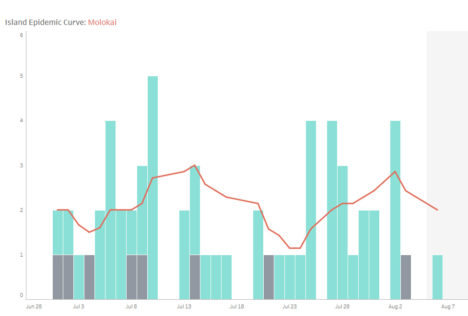COVID Cases Stay Steady, CDC Guidelines Updated
By Catherine Cluett Pactol | Editor

COVID cases on Molokai, July – Aug. 10. Graph courtesy of DOH.
Last week there were six new COVID cases reported on Molokai between Aug. 3 and Aug. 10, according to the Dept. of Health as of Aug. 15. New cases have leveled off over the past month, ranging between about six and 15 per week reported. This number represents those cases officially reported and does not include results obtained through home tests.
Statewide, there has been a slow decline in cases reported over the past couple of months, after a spike in cases at the end of May.
Last week, the Centers for Disease Control and Prevention (CDC) updated its guidelines for COVID-19 to “help people better understand their risk, how to protect themselves and others, what actions to take if exposed to COVID-19, and what actions to take if they are sick or test positive for the virus.”
“We’re in a stronger place today as a nation, with more tools—like vaccination, boosters, and treatments—to protect ourselves, and our communities, from severe illness from COVID-19,” said Greta Massetti, PhD, MPH, author of the CDC’s Morbidity and Mortality Weekly Report. “We also have a better understanding of how to protect people from being exposed to the virus, like wearing high-quality masks, testing, and improved ventilation. This guidance acknowledges that the pandemic is not over, but also helps us move to a point where COVID-19 no longer severely disrupts our daily lives.”
While the CDC continues to recommend vaccination and boosting as a key component in protection against COVID, its new guidelines don’t differentiate between those who are vaccinated and those who are not in regards to what actions to take if you are exposed to or test positive for the virus.
The update recommends that instead of quarantining if you were exposed to COVID-19, you wear a high-quality mask for 10 days and get tested on day five.
Regardless of vaccination status, the guidelines continue to recommend that you should isolate from others when you have COVID-19. You should also isolate if you are sick and suspect that you have COVID-19 but do not yet have test results. If your results are positive, follow CDC’s full isolation recommendations. If your results are negative, you can end your isolation.
If you test positive for COVID-19, the CDC recommends that you stay home for at least five days and isolate from others in your home. You are likely most infectious during these first five days. Wear a high-quality mask when you must be around others at home and in public. If you had moderate illness (shortness of breath or difficulty breathing) or severe illness (you were hospitalized) due to COVID-19 or you have a weakened immune system, you need to isolate through day 10. If you have ended isolation and your COVID-19 symptoms worsen, restart your isolation at day zero. Talk to a healthcare provider if you have questions about your symptoms or when to end isolation.
Recommending screening testing of asymptomatic people without known exposures will no longer be recommended in most community settings, according to the CDC.
The CDC also now emphasizes that physical distance is just one component of how to protect yourself and others.
“It is important to consider the risk in a particular setting, including local COVID-19 Community Levels and the important role of ventilation, when assessing the need to maintain physical distance,” states the CDC. For more information on how ventilation systems contribute to a safer environment, visit the link to know more about this.
As of Aug. 11, Maui County’s community level was classified as “high.” COVID community levels can help individuals and communities decide which prevention actions to take based on data of recent cases and hospitalizations. Using this data, communities are classified as low, medium or high.











Don't have a Molokai Dispatch ID?
Sign up is easy. Sign up now
You must login to post a comment.
Lost Password